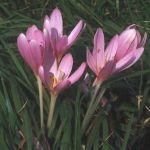| Common Name: |
Upstart |
| Other Names: |
Autumn Crocus, Colchicum, Crocus, Meadow Saffron, Naked Ladies |
| Botanical Name: |
Cochicum autumnale |
| Genus: |
Cochicum |
| Family: |
Colchicaceae |
| Native Location: |
Europe to the Ukraine |
| Cultivation: |
Moisture-retentive soil in sun or semi-shade, allowing space for large leaves to develop in spring. Slugs may damage corms. |
| Propagation: |
By seed sown when ripe; by separation of corms or offsets in summer. Seeds may take 18 months to germinate. |
| Harvest: |
Corms are lifted in summer, and seeds collected in early summer; both are dried for use in liquid and dry extracts, and tinctures. |
| Variations: |
Alboplenum
Has double white flowers
Album
Has white flowers
Pleniflorum syn. Roseum Plenum
Has double flowers. |
| Height: |
30cm (12in) |
| Hardiness: |
Z5-8 |
| Parts Used: |
Corms, seeds, Tuber (fleshy, rounded stem or root) |
| Properties: |
A bitter, acrid herb that relieves pain and reduces inflammation. |
| Medicinal Uses: |
Internally for acute gout, Behÿet's syndrom, familial Mediterranean fever, and scleroderma. Externally for neuralgia. For use by qualified practitioners only. Excess causes gastric pain, diarrhea, and renal damage. May cause fetal abnormalities; not given to pregnant women or patients with kidney disease. Prolonged use may cause hair loss, blood disorders, muscular pain and weakness, and tingling in hands and feet. Used in homeopathy for joint pains, diarrhea, and nausea caused by wet weather.
To treat psoriasis, gout, Mediterranean fever, gastrointestinal inflammation, asthma, and lice. Germany's Commission E has approved the use of colchicum bulbs, seeds, and flowers to treat Mediterranean fever and gout. |
| Warning: |
All parts are highly toxic if eaten. Handling of corms may cause skin allergy.
This herb and its alkaloids are subject to legal restrictions in some countries. |
| Typical Dose: |
There is no typical dose of colchicum. The herb is considered toxic and is rarely used. |
| Possible Side Effects: |
Colchicum's side effects include thirst, burning of the mouth and throat, nausea, vomiting, and diarrhea. |
| Drug Interactions: |
| Taking Colchicum with this drug may be harmful: |
| Colchicine, (ratio-Colchicine)—May enhance drug's therapeutic and adverse effects. |
|
| Lab Test Alterations: |
May decrease serum uric acid concentrations. |
| Bibliography: |
Encyclopedia of Herbs by Deni Brown Copyright © 1995, 2001 Dorling Kindersley Limited Pg 176
The Essential Herb-Drug-Vitamin Interaction Guide by Geo. T. Grossberg,MD and Barry Fox,PhD Copyright©2007 Barry Fox,PhD Pg 157 |
